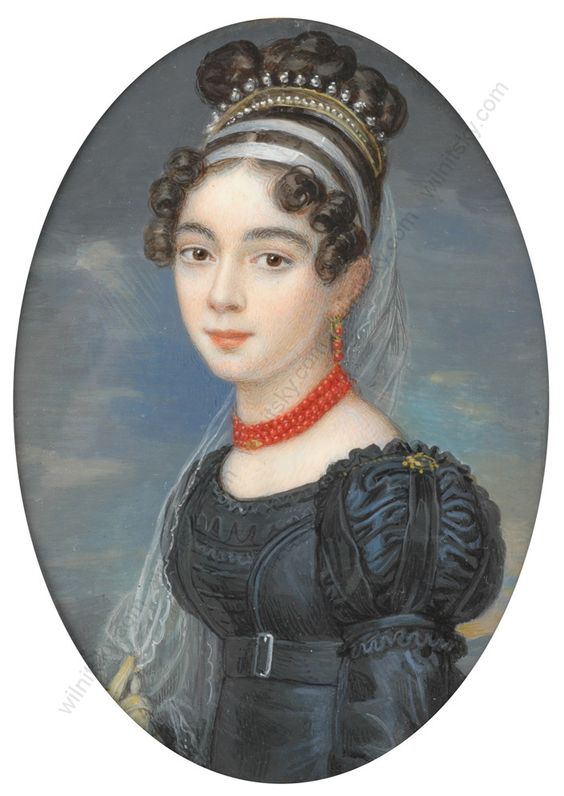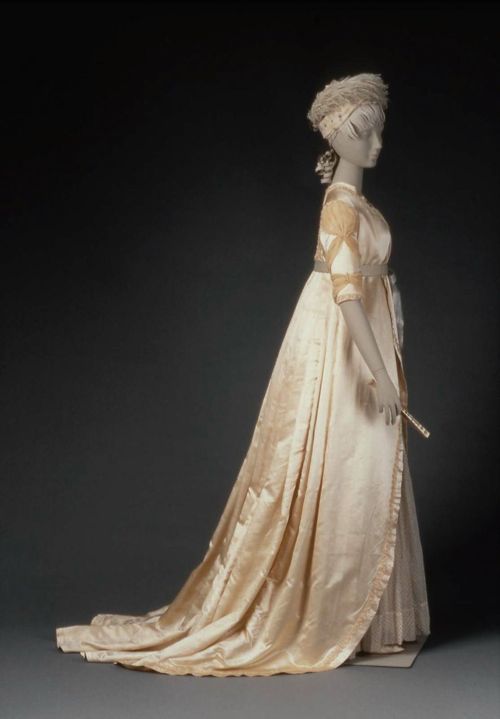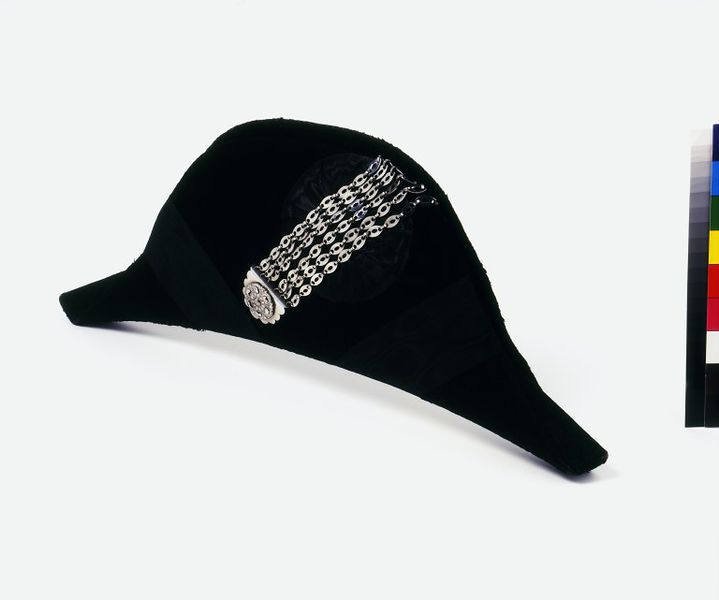The Historical Sew Monthly Challenge #9 is Historicism: Make a historical garment that was itself inspired by the fashions of another historical period.
Up until the early 19th century, to the best of my knowledge (caveat: my pre 1660 fashion history is pretty weak, so I’m happy to be corrected here!) historicism in fashionable dress was predominantly focused on emulating and borrowing from ancient Greek and Rome. I say fashionable dress, because regional styles in certain areas often used elements that went out of fashion in the main centres decades, if not centuries, before. This isn’t historicism in its truest sense, because its a case of styles stagnating, rather than intentionally borrowing from the past.
Depending on how you look at historicism, one exception to the reliance on ‘the ancients’ as an inspiration from the past is the robe de coer. The robe de coer, based on Louis the Sun King’s favourite elements of female dress in his youth in the 1660s and 70s, was implemented as the required court dress in France in the late 17th century, and spread from there to other courts around Europe. It remained the official dress until the fall of the French monarchy at the end of the 18th century, and while it was updated somewhat to match current styles, it retained clear traces of its 17th century origins to the end.
Read more about robe de cour here.

Sofia Magdalena’s wedding gown, robe de cour, worn at the wedding at the Palace Church November 4, 1766.
Historicism really took off at the end of the 18th century thanks to the obsession with all things classical that was sparked by excavations at Pompeii and Herculaneum.
Turn-of-the-19th century accessories could also have a Grecian flair, as seen in these sandals from the Bata Shoe Museum:
And tiara modelled after laurel wreaths:
Historicism stayed trendy, even as the Greco-Roman fad faded from the 1810s onwards. The next big focus of interest was the Renaissance and Elizabethan ages, evoked through frilled fichu which echoed Elizabethan ruffs:
And standing, pointed ruff collar, as well as the segmented, puffed sleeves known variously as mameluke, marie, juliet or gabrielle sleeves, the later of which names hint at the Renaissance heroines they were meant to evoke:
Sleeves also featured elaborate slash effects, based on Renaissance examples:

Attr. to Joseph Krafft, Portrait of Henriette Rottmann, 1820, via wilnitsky.com
As skirts widened in the 1830s and 40s, design elements were lifted from the last period of full skirts, the 18th century. Note how the fichu robings on this 1840s dress so clearly echo the wrapped fichu of later 18th century styles:

Robe de matin à l’Anglaise avec des manches en amadis jupon coupe à grand volant de mousseline fichu à double garniture Cette femme est coëffee d’un chapeau de Vegogne a long poil avec un ruban au tour, Gallerie des Modes, 1782, MFA Boston
Possibly the simplest and most direct form of historicism is the use of older fabrics, and the re-making of older fashions, into newer styles. 18th century brocades silks were particularly popular for re-use, as in this 1840s evening gown:
The 1860s saw a brief neoclassical in fashion, usually in accessories, such as the following diadem, though the vogue (fashionable in some places, obligatory formal occasions at Napoleon IIIs court) for white evening gowns draped in gauzy fabrics which helped Charles Worth to make his name could also be argued to be an example of the neoclassical revival.
In the 1850s, helped by Napoleon III’s desire to gain legitimacy by positioning himself as the true heir to Napoleon and the French Monarchy, and by Eugenie’s fascination with Marie Antoinette, everything 18th century was fashionable again:
From bergere hats (learn more about them here):
To warp printed silks, which were called ‘Pompadour silks’:
(learn more about warp printed/chine silks here)
And Louis or Pompadour heels (more about them here):

Evening shoes with Louis heels, 1875—85, French, silk, glass, The Metropolitan Museum of Art, 2009.300.1582a, b
….the 18th century was a perpetually popular source of inspiration in the later half of the 19th century:
Tea gowns are one of the most frequent types of garments to utilise historicism, to the point that strong historical or exotic references are almost part of the definition of what makes a garment a tea gown. Read more about them here.

Tea gown with 18th century inspired back pleats, ca. 1905, Callot Soeurs, silk damask, lace, Victoria & Albert Museum
The new century saw a new obsession with ancient Greek and Rome, called the neoclassical revival, and characterised by the raised waist of the Empire line. Examples could borrow directly from Greek and Roman garments:
Or through the lens of early 19th century Neoclassicism:

Evening dress,
House of Drecoll, 1910, silk, rhinestones, Metropolitan Museum of Art, 2009.300.2500
The Empire line came into vogue in 1908, but it remained fashionable into the late ‘teens and ’20s:
Historicism can sometimes blend with exoticism, as in the 1910s and 20s fad for all things Oriental (hugely inspired by the Arabian nights), and, more obviously, in Egyptomania, which was took its cue not from modern Egypt, but from Ancient Egypt:
Another element of 1920s fashions was a rebellion against the straight, androgynous line, particularly through Robe de Style, which borrowed freely from 18th century and mid-19th century designs for inspiration:
Smaller elements of the past made their way onto accessories like purses:
While 1930s fashions often look like the epitome of sleek modernity, they often used elements of the past for inspiration in small, subtle ways. Designers looked back to the 18th century:

This evening dress comes from a very important dress making establishment and goes by the name of Charlotte Corday. Made up in white mousseline de soie with a red stripe, completed with a fichu of the 1790s Auckland Star, 11 January 1936
To the Romantic era:

In printed crepe-de-chine–powderblue scattered with flowers–this afternoon dress, with its little velvet bolero and corselet to match, and its 1830 sleeves, strikes an original note Evening Post, 5 September 1931 via Papers Past
And as recently as the 1910s, for touches such as these flounced hip ruffles:
And quirky statement pockets:
While most examples of historicism appear in women’s fashions, there are elements of menswear that looked back to earlier periods too.
This greatcoat, ca 1810, features buttons that nod to earlier periods, when menswear was more elaborate, and back vents, originally seen in the 17th century, which were originally intended to allow a sword to project through the vent.
While womenswear borrowed heavily from the medieval and Renaissance periods in terms of applied decorations in the 1820s and 30s, menswear sometimes took the simplest route of historical interpretation, as in this waistcoat made of fabrics depicting jousting knights:
Weddings, as formal, traditional occasions, often involved clothes that evoke elements of the past, as seen in these mid-century wedding vests, with embroidered designs that give an obvious nod to 18th century waistcoats:
Breeches ceased to be standard menswear for business in the 1810s, but they did not disappear entirely. They were retained as standard attire for the most formal of occasions: at court, where mens dress retained all the elements of formal 18th century menswear into the early 19th century:
They also made appearances in the least formal type of outerwear: sportswear:
Note how much this sporting suit looks like a late 18th century example:
Men’s leisurewear, particularly robes and smoking jackets, often evoked earlier styles. This dressing gown is heavily influenced by 17th and 18th century banyan in shape, and also has a more direct form of historicism: it’s made from an earlier 18th century paisley shawl, which has been cut up and re-used now that it is no longer fashionable:
This turn-of-the-20th century smoking suit nods to the 1860s with its vivid aniline dyed shades, and uses rolled collars and touches of quilting also borrowed from mid-century designs.

BEALE & INMAN, A GENTLEMAN’S SMOKING SUIT c. 1900 vivid red and purple silk satin suit comprising drawstring trousers and jacket, with quilted lapels and accents, sold at Christies
For more examples of Historicism, check out the V&A Nineteenth-Century Fashion in Detail book, by Lucy Johnson, which has a whole chapter on historicism.
And these pinterest boards:
Historicism (sadly in need of annotation and organising – will try to get to that).
Pompeii to Paris: Classical Inspiration
And these Rate the Dress posts:
1825 with Renaissance inspiration
1885 childrenswear with 18th century inspiration
A paisley tea gown featuring re-use and 18th century inspiration
A Grecian-inspired 1910 evening dress or tea gown
Other relevant posts:































Quite an eye opening post! Thank you for taking the time to write up this chronology and hunt down all these examples.
YES! Very super interesting.
sewcharacteristicallyyou.comI think it is very interesting to see the elements from different eras that have been taken and applied to a whole new fashion decade.
Sarah
http://www.sewcharacteristicallyyou.com/blog
I love the way extra things seem to be appearing on this post. So many good things!
Except for that purple and red striped smoking suit. Yikes!
Checking in from Matsukaze Workshops, with my rendition of the Dungiven trousers.
http://matsukazesewing.blogspot.com/2016/09/obnoxiously-plaid-skinny-pants-and.html
I made, of course, a 1920s robe de style:
https://aboutmybuttonbox.wordpress.com/2016/09/29/das-gansblumchenkleid-the-daisy-dress/